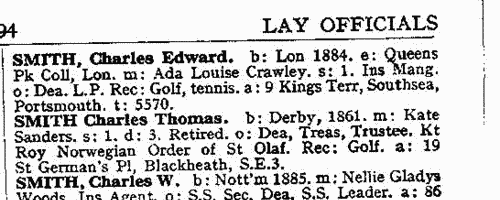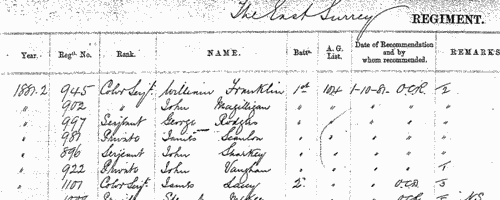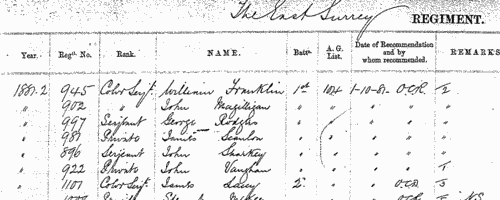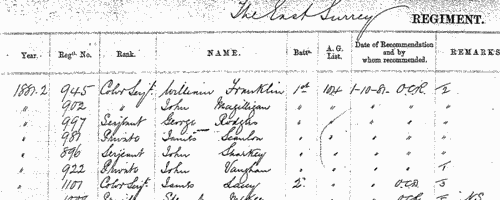Botting Surname Ancestry ResultsOur indexes 1000-1999 include entries for the spelling 'botting'. In the period you have requested, we have the following 160 records (displaying 91 to 100): Single Surname Subscription | | | Buying all 160 results of this search individually would cost £924.00. But you can have free access to all 160 records for a year, to view, to save and print, for £100. Save £824.00. More... |
These sample scans are from the original record. You will get scans of the full pages or articles where the surname you searched for has been found. Your web browser may prevent the sample windows from opening; in this case please change your browser settings to allow pop-up windows from this site.  London Policemen
(1830-1842) London Policemen
(1830-1842)
The Metropolitan Police Register of Joiners (MEPO 333/4) lists policemen joining the force through to 31 December 1842 (to warrant number 19892). The register is alphabetical, in so far as the recruits are listed chronologically grouped under first letter of surname. It is evidently a continuation of a similar earlier register, not closed until its alphabetical sections were filled: consequently, there are no entries in this register for the initial letters N, O, Q, U, V, X, Y or Z; and the sections of this register start at different dates - A 18 April 1840 (warrant number 16894); B 11 December 1830 (5570); C 7 September 1830 (4988); D 27 May 1833 (8445); E 15 December 1838 (14476); F 30 March 1832 (7372); G 1 December 1835 (11,184); H 25 April 1832 (7457); I and J 13 February 1837 (12449); K 2 January 1838 (13457); L 3 October 1834 (9905); M 15 November 1832 (7999); P 4 October 1831 (6869); R 4 September 1837 (13021); S 30 March 1835 (10366); T 6 April 1840 (16829); W 30 December 1833 (9096). The register gives Date of Appointment, Name, Number of Warrant, Cause of Removal from Force (resigned, dismissed, promoted or died), and Date of Removal. Although the register was closed for new entrants at the end of 1842, the details of removals were always recorded, some being twenty or more years later. Those recruits not formerly in the police, the army, or some government department, were required to provide (normally) at least two letters of recommendation from persons of standing, and details of these are entered on the facing pages: the names in these are indexed separately - this index refers only to the police constables. Where a recruit was only recently arrived in the metropolis, the names and addresses of the recommenders can be invaluable for tracing where he came from.BOTTING. Cost: £8.00.  | Sample scan, click to enlarge

|  Apprentices
(1760) Apprentices
(1760)
Apprenticeship indentures and clerks' articles were subject to a 6d or 12d per pound stamp duty: the registers of the payments usually give the master's trade, address, and occupation, and the apprentice's name, as well as details of the date and length of the apprenticeship. 1 January to 31 December 1760.BOTTING. Cost: £8.00.  | Sample scan, click to enlarge

|  Apprentices
(1754) Apprentices
(1754)
Apprenticeship indentures and clerks' articles were subject to a 6d or 12d per pound stamp duty: the registers of the payments usually give the master's trade, address, and occupation, and the apprentice's name, as well as details of the date and length of the apprenticeship. 2 August to 31 December 1754.BOTTING. Cost: £8.00.  | Sample scan, click to enlarge

|  Masters of apprentices
(1755) Masters of apprentices
(1755)
Apprenticeship indentures and clerks' articles were subject to a 6d or 12d per pound stamp duty: the registers of the payments usually give the master's trade, address, and occupation, and the apprentice's name, as well as details of the date and length of the apprenticeship. 1 January to 31 December 1755.BOTTING. Cost: £8.00.  | Sample scan, click to enlarge

|  Masters of apprentices
(1756) Masters of apprentices
(1756)
Apprenticeship indentures and clerks' articles were subject to a 6d or 12d per pound stamp duty: the registers of the payments usually give the master's trade, address, and occupation, and the apprentice's name, as well as details of the date and length of the apprenticeship. 1 January to 11 September 1756.BOTTING. Cost: £8.00.  | Sample scan, click to enlarge

|  British artillerymen fighting in South Africa
(1899-1902) British artillerymen fighting in South Africa
(1899-1902)
The Queen Victoria's South Africa Medal was awarded (after her death, in the event) to all who had served honourably in the various campaigns in the Boer War. Returns were made from each unit, and consolidated into nominal roll, of which this is the one for the Royal Artillery. Confusingly, the ledgers used had originally been printed for a register of men transferred (or re-transferred after mobilization) to 1st Class Army Reserve. All the original column headings were therefore struck through, and the roll was prepared with this information: Date of Issue; Regimental Number; Rank; Name; Unit; Medal (a 1 indicating that a medal was awarded); [number of] Clasps; the reference to the source in the original returns, usually starting with AG for papers in the hands of the Adjutant-General, and 68/Art/ for the Royal Artillery records. The final column, normally left blank, was occasionally used for explanatory remarks.BOTTING. Cost: £8.00.  | Sample scan, click to enlarge

| Congregationalists
(1935)
Who's Who in Congregationalism gives biographical notices of accredited ministers and evangelists, lay pastors and lay officials of the Congregational church in Britain and Ireland. The notices also include the names of wives, with maiden names, and these too are included in the index here.BOTTING. Cost: £6.00.  | Sample scan, click to enlarge

|  Outstanding soldiers of the Gordon Highlanders
(1881-1901) Outstanding soldiers of the Gordon Highlanders
(1881-1901)
Each year the best soldiers of the regiment were chosen for long service and good conduct medals. This register gives rank, name, regimental number, and date of recommendation. (The sample scan is from the East Surrey regiment). The register is essentially a register of recommendations, annotated with details of the issue of the medals. Where no gratuity accompanied the medal, the entry is marked 'W. G.' (without gratuity); where, for one reason or another, the medal was not issued, the entry is marked 'N. S.' (not sanctioned) and struck through. The regiment was based on the 75th Regimental District - Aberdeen. The 1st battalion was moved from Malta to Egypt in 1882, and added "Egypt, 1882, 1884", "Tel-el-Kebir" and "Nile 1884-1885" to the regimental honours. It was moved to Malta in 1885; on to Ceylon in 1888; and from there to India in 1891, being stationed at Rawul Pindee by 1895. It took part in the Chitral Relief Force of 1895, and the North West Frontier campaign of 1897 to 1898, adding "Chitral" and "Tirah" to the honours. The battalion returned to Scotland in 1898, but was sent out for the South African war in 1899. The 2nd battalion was moved from India to South Africa in 1881, taking part in the Boer war, returned home in 1882, and by 1885 was stationed at Devonport. It was sent to the Channel Islands in 1885; to Ireland in 1887; and back to Scotland in 1891, and by 1895 was stationed at Glasgow. It was moved to England in 1896; to India in 1898; and to South Africa in 1899. The two battalions added "South Africa, 1899-1902", "Paardeberg" and "Defence of Ladysmith" to the colours.BOTTING. Cost: £8.00.  | Sample scan, click to enlarge

|  Outstanding soldiers of the Hampshire Regiment
(1881-1901) Outstanding soldiers of the Hampshire Regiment
(1881-1901)
Each year the best soldiers of the regiment were chosen for long service and good conduct medals. This register gives rank, name, regimental number, and date of recommendation. (The sample scan is from the East Surrey regiment). The register is essentially a register of recommendations, annotated with details of the issue of the medals. Where no gratuity accompanied the medal, the entry is marked 'W. G.' (without gratuity); where, for one reason or another, the medal was not issued, the entry is marked 'N. S.' (not sanctioned) and struck through. The regiment was based on the 37th Regimental District - Winchester. The 1st battalion returned from India 5 April 1875, set off again for India in 1884 and by 1885 was stationed on Malta and in 1895 is found at Ranikhot in Bengal. The 2nd battalion embarked for India 1 November 1872 and in 1885 was at Cannanore in Madras. Moving to Burmah in that year, the battalion took part in the surrender of Mandalay ("Burmah, 1885-1887"); it returned to India in 1887, and from India to England 7 February 1888. In 1894 it was transferred to Ireland, and by 1895 was stationed at the Curragh. In 1900 the troops were sent to South Africa, and fought at Paardeberg, the occupation of Bloemfontein, the advance on and the occupation of Johannesburg and Pretoria ("South Africa, 1900-1902", "Paardeberg"). BOTTING. Cost: £8.00.  | Sample scan, click to enlarge

|  Outstanding soldiers of the Royal Sussex Regiment
(1881-1901) Outstanding soldiers of the Royal Sussex Regiment
(1881-1901)
Each year the best soldiers of the regiment were chosen for long service and good conduct medals. This register gives rank, name, regimental number, and date of recommendation. (The sample scan is from the East Surrey regiment). The register is essentially a register of recommendations, annotated with details of the issue of the medals. Where no gratuity accompanied the medal, the entry is marked 'W. G.' (without gratuity); where, for one reason or another, the medal was not issued, the entry is marked 'N. S.' (not sanctioned) and struck through. The regiment was based on the 35th Regimental District - Chichester. The 1st battalion moved from Cyprus to Egypt in 1882, moving into the Soudan in 1884, and fighting at Abu Klea - adding "Egypt, 1882", "Nile, 1884-5" and "Abu Klea" to the regimental honours. The battalion returned to England in 1885, and was transferred to Ireland in 1891 (was at Fermoy in 1895) and back to England in 1896. The battalion was sent out to Malta in 1899, and on to South Africa in 1900, adding "South Africa, 1900-1902" to the colours. The 2nd battalion embarked for Malta in 1882, and went on to Egypt and India in 1885, where it was established at Dum Dum by 1895. It took part in the Hazara Expedition of 1888 and the North West Frontier Campaign 1897 to 1898.BOTTING. Cost: £8.00.  | Sample scan, click to enlarge

|
Research your ancestry, family history, genealogy and one-name study by direct access to original records and archives indexed by surname.
|













